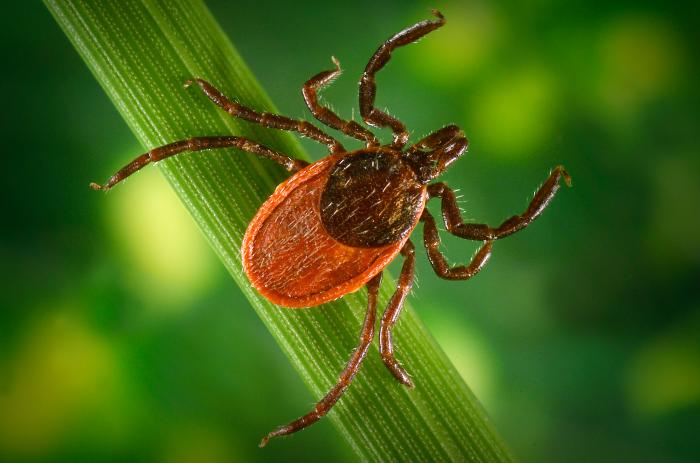 |
| A blacklegged tick, photo provided by: CDC/ James Gathany; William Nicholson |
Did you feel that? That little tickle, running up your leg, or maybe that traveling tingle up your neck... You can feel it now can't you? Even though your certain they aren't on you... They're tiny. They're tenacious. They're TICKS and if you're out in the woods (or even your own backyard) you'll most likely see them.
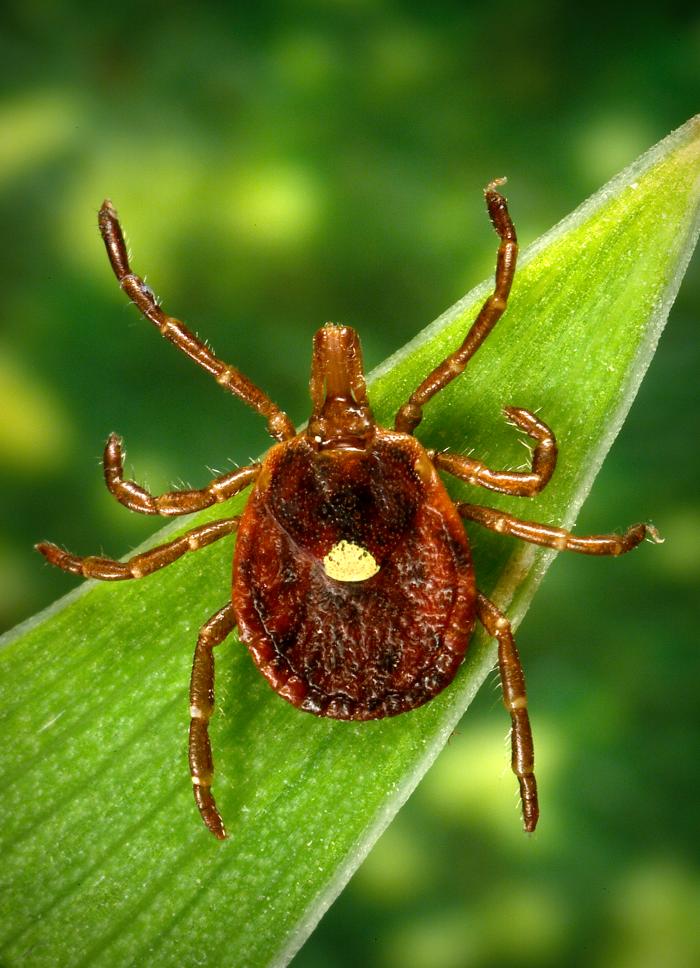 |
| A questing Lone Star Tick. Photo Courtesy: CDC/ Dr. Amanda Loftis, Dr. William Nicholson, Dr. Will Reeves, & Dr. Chris Paddock |
Believe it or not, ticks are arachnids, relatives of those other infamous creepy crawlers, spiders! Most ticks will go through four life stages: beginning with an egg, emerging as a larva (which has only six legs, not eight), then an eight legged nymph, and finally a full on, breeding adult. After emerging from their egg stage, ticks require a blood dinner or two at each stage to continue their parasitic little lives. In fact, most ticks cannot progress into the next life stage until they have fed. Being equal opportunity blood suckers, ticks will feed on mammals, reptiles, birds and amphibians, but they do prefer certain hosts during their different life stages, if you'd like to see if you are the current soup du jour as you take your trek, see this diagram courtesy of the Centers for Disease Control (CDC), but make no mistake, ticks are opportunistic and will take any host that will provide. Life for a tick is pretty simple, feed or die. In order to find a host, the tick will usually "quest". A questing tick will position itself on the edge of a leaf, stick, blade of grass, or other vegetation and then stretch out their first two pairs of legs and awaits a host to brush against them. Ticks don't just quest blindly, in fact, they use signals such as CO2 levels and (for some) their eyesight to decide where to "hang" around for a meal. To figure out what types of ticks you should keep an eye out for visit the CDC's Geographic Distribution page.
 |
| The easiest way to avoid ticks while hiking is to simply stay on the trail, avoiding weeds, leaf litter and low lying branches that may contain ticks. |
Good question. While there is no 100% sure fire way to keep ticks from burying their nasty capitulum (it looks a lot like a head) into your skin, you can certainly take steps to make yourself as a less appealing meal (like kids and broccoli). First you can avoid wooded areas and heavy leaf litter, ticks dig those places, along with dense areas of large leafed plants (it's nice and humid under there) such as the invasive Kudzu vine. To lessen your chances of picking up a blood sucking hitchhiker while hiking, walk in the center of the trail, avoiding contact with underbrush, weeds, leaf litter and low hanging branches whenever possible. You can also spray your skin and clothing down with an insect repellant that contains 20-30% DEET (follow the instructions on the can), and if you're looking for even more protection spray a bit of permethrin on your clothing (this is POWERFUL MOJO and will stay on the clothing for multiple washings, DO NOT SPRAY ON YOUR SKIN), and of course you could try out one of the homemade concoctions that are right here on the blog as well. Clothing helps, long sleeves, pants, a hat and even wearing light colored clothing will help lower the amount of ticks that can use you as a buffet. Ticks are generally most active during the warm months, April - September, but they are out there, looking for a meal, year round so always be vigilant.
 |
| Don't forget about your hairy buddy! Photo Credit: CDC/ Dawn Arlotta / Cade Martin |
Tick Check!
As you hike be sure to take intermittent "tick checks" no longer than every two hours, paying special attention to your: underarm area, under socks, ears, belly button, behind your knees, around your waist (especially your belt area), and hair. Before you leave an area be sure to check yourself, pets and gear for ticks, they may be loose and seek you out later (maybe in the car...cringe!). Once home take a shower and perform another check in a full length mirror (if possible), paying particular attention to places you didn't want hanging out on the trail and your hair. Always be sure to trust your body, if you feel something crawling take note and examine to see if it is a tick (sometimes you may creep yourself out though and your body will "crawl" for a while after finding one). And if you have a hairy hiking buddy (or a dog), be sure to check your best buddy for ticks and give him (or her) a good washing when you get home, checking for ticks as you rub them down. For more ways to prevent ticks on your pets, visit the Center for Disease Control's page.
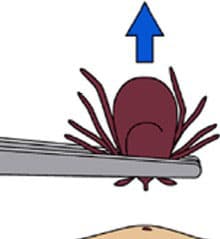 |
| Apply steady, even pressure and pull tick up and out. Illustration: CDC website |
WHAT DO I DO?
First, keep calm, there's no reason to panic (unless the tick is over 20 pounds. In that case, call Guinness, then panic). If you are panicking, and happen to like Country music and Brad Paisley you could listen to this to calm yourself. There are plenty of tick removing methods out there (and even more old wives tales), but the most effective tick removal system to date requires only your fingers and a pair of pointy tweezers, pretty high tech, huh? With your tweezers in hand, here's what to do:
- Disinfect the pointy tweezers with a bit of rubbing alcohol or a bit of flame (allow tweezers to cool if flame is used). We use the pointy type because you run less of a risk of squishing the tick with the pointy ones than with the thick ended pairs.
- Use the tweezers to get a grip on the tick's "head" (capitulum), as close to your skin as possible. Try not to squeeze the tick's body, as that may lead to the tick secreting its body fluids into you.
- After establishing a decent grip on the parasite, pull up with steady, even pressure. DON'T twist the tick, DON'T jerk the tick, by manipulating the tick that way you may break off the tick's mouth parts leaving them lodged in your skin. Didn't listen to me or have the mouth parts break off anyway? Don't worry. Attempt to establish a grip on the severed mouth parts and remove them from your skin, again, use steady even pressure. If they still will not come out, leave the area alone and allow your skin to heal, if you notice any abnormalities contact your physician.
- After you've removed the blood sucker, be sure to wipe the area down with rubbing alcohol, iodine or some other disinfectant. I follow that up with a touch of triple antibiotic ointment and disinfect the tweezers as well.
- Keep an eye on the area. If you find yourself with a rash, fever, muscle/joint soreness, fatigue or other symptom call your doctor and be sure to tell them about your recent tick bite.
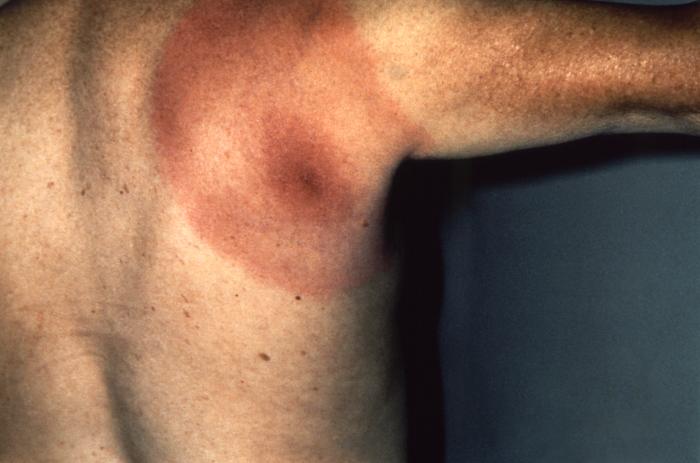 |
| A "Bulls Eye" rash, usually indicates the presence of Borrelia burgdorferi the bacterium responsible for Lyme disease. Photo: CDC |
What could it have given me?
Tickborne illnesses have many of the same symptoms, and these symptoms usually show themselves within 30 days.
- A fever and/or chills - The degree and extent vary.
- Aches and pains - The most common are headaches, fatigue and muscle pains. Joint pain is a common complaint additional symptom from those suffering from Lyme disease.
- A rash - Treat any rash near the tick bite as serious and visit your doctor. Some tickborne illnesses have distinct rashes, that usually precede a fever.
- Lyme Disease: A "Bulls Eye" rash (see photo to above right) may appear 3-30 days after the tick bite. A fever is usually not far behind the appearance of the rash. 70-80% of patients will exhibit the rash if infected, so just because you don't see a rash doesn't mean you may not have it.
- Southern Tick Associated Rash Illness (STARI): Shows a "Bulls Eye" rash similar to Lyme disease, and will originate from the bite site of the lone star tick.
- Rocky Mountain Spotted Fever: Most often a rash of small, flat, pink, non-itchy spots begins to appear on the infected person's wrists, ankles and forearms 2-5 days after the bite. The rash may spread slowly to the trunk and the palms of the hands and soles of the feet. 10% of patients with Rocky Mountain Spotted Fever never develop a rash.
- Tularemia: Those infected with Tularemia will usually form an ulcer at the tick bite site. The infection will sometimes spread to nearby lymph nodes as well, such as those located in the groin and armpit areas.
- Paralysis - Tick paralysis is a very rare tickborne disease, thought to be brought about by toxins contained in the tick's saliva. The symptoms may be confused with other neurological diseases and maladies. Once the tick is found and removed the paralysis usually subsides within 24 hours.
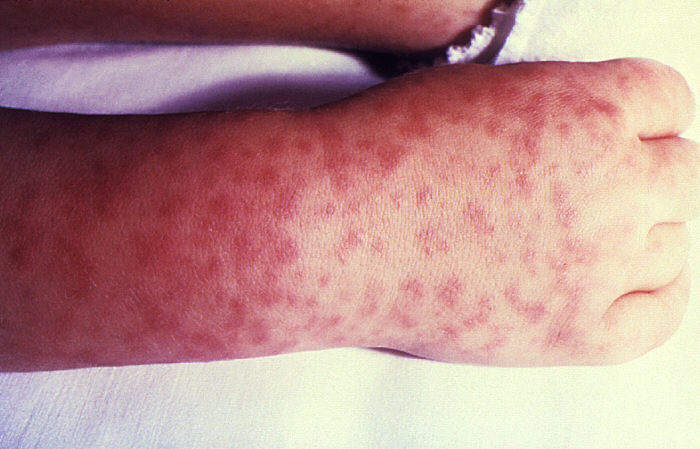 |
| An example of the Rocky Mountain Spotted Fever rash type. Photo: CDC |
But don't stay out of the woods!
Ticks should not be any reason to keep you out of the woods or off the trails, with a bit of prevention and spot tick checks often, you can continue to enjoy the outdoors, all you really need is light colored clothing and insect repellent to keep your treks relatively tick free!
I hope you enjoyed this entry, if you have any questions or comments, post them below and don't forget to follow on facebook at: https://www.facebook.com/LocalTreks
Additional Information and Websites referred to:
Center for Disease Control & Prevention: Ticks
HowStuffWorks: "How Ticks Work"
Missouri Department of Conservation: Ticks